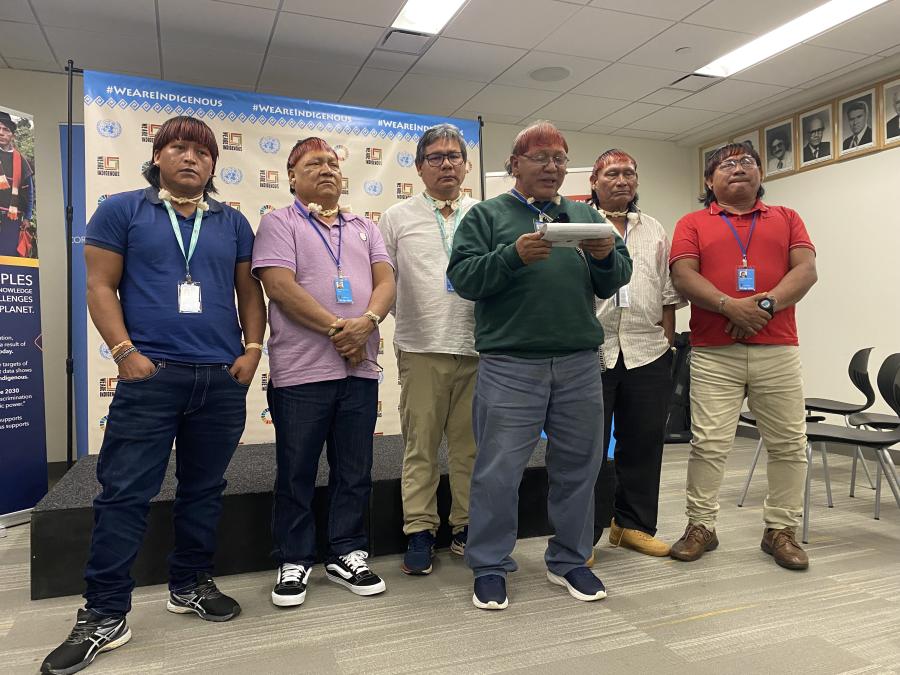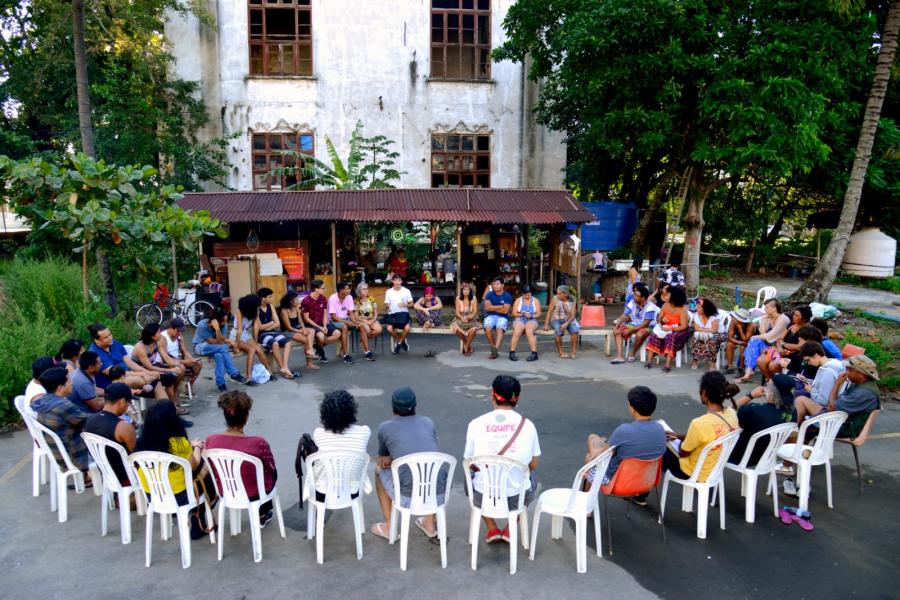Polonoroeste Update
In February 1985, for the first time, the World Bank halted payments on a loan because of environmental problems and threats to the integrity of indigenous populations. The loan was for what has become perhaps the most notorious multilaterally financed development project ever - the Northwest Region Integrated Development Program (Polonoroeste), a $1.6 billion project to pave 1,500 km of road and resettle migrants in the Brazilian Northwest. The cutoff came after several years of intensive, international criticism of the project from indigenous rights and environmental organizations. Congressional hearings dealing with the project and increasing concern over the impacts on indigenous peoples and the environment of multilateral bank-financed projects in general on the part of the Foreign Operations Subcommittees of the Senate and House Appropriations Committees followed an intensive advocacy campaign Environmental Defense Fund Attorney Bruce Rich orchestrated. But even after the new Brazilian government came to power in 1985 (Brazil's first civilian regime after 20 years of military rule) and took a series of steps to rectify the worst problems and get the World Bank to renew payments, the situation remains a tragedy.
Uncontrolled Migration
The most persistent, and visible problem - immediately for the indigenous populations, but ultimately for everyone involved - is the massive, uncontrolled migration to the Northwest. The plan the World Bank and the government agreed to in 1980 was designed to rationalize and control this process. Indigenous lands were to be demarcated and protected, forest reserves were to be established and colonists were to be settled on small holdings suitable for sustainable agriculture, with access to credit for tree crops such as coffee and cacao.
With recession, unemployment and consolidation of landholdings for mechanized export agriculture in the rest of Brazil, however, the Northwest became a safety valve for social conflicts in other areas. The area was advertised on TV as an El Dorado for the poor, and the migrants poured in. In 1984 150,000 migrated to the state of Rondonia, while INCRA, the government land agency, only had lots for 5,000 families - about 20,000 people. Very little of the land in the area supports annual cropping. A good deal of the land that does is already held by large private owners. Consequently, settlers clear land that is unsuitable for agriculture, their crops fail and they are forced to move, clear more forest and sell what they had to cattle ranchers or speculators. This process has brought Rondonia the fastest rate of deforestation in Amazonia. If this rate continues, it is estimated that by 1990 the area (about the size of England) will be totally deforested.
For the colonists, the supposed beneficiaries of the project, the situation has produced serious, often brutal, social disruption. The Comissao Pastoral da Terra (the Catholic Church organization that deals with land issues) recently reported cases of the disappearance of families and of the enslavement of migrants.
For the indigenous peoples most recently contacted, uncontrolled migration has drastically reduced their subsistence base, caused epidemics and provoked violent confrontations with colonists who invaded their territory. The military government in effect treated the loan conditions regarding demarcation of indigenous lands with contempt; in many areas not even the minimal step of legal protection of the indigenous lands has been taken. Of the 55 indigenous areas in the region influenced by the Polonoroeste program, only four are fully protected by law. While most of the areas have some form of legal recognition as indigenous land, 14 groups, whose presence the Brazilian anthropologists who evaluate the indigenous peoples' aspects of the project attest to, do not even have identified areas, the first step toward legal recognition of land rights.
Demarcation
Demarcation of indigenous lands was a major point in halting the loan. After the cutoff, the government demarcated 1.8 million hectares partially as a reserve for the Uru-eu-wau-wau Indians (only officially contacted in 1984) and partially as a national forest. In addition, it gave full legal recognition to two Nambiquara areas (Sarare and Guapore) as well as demarcated a reserve for the Zoro and removed invaders from the Lourdes reserve of the Gavioes. But even with demarcation, as long as migration continues at present rates, invasions will continue to menace the indigenous populations.
Demarcation is a first step, but in Rondonia it was difficult and costly because it was carried out after indigenous areas had already been overrun. In the Uru-eu-wau-wau area, several hundred families of poor colonists were removed and will be indemnified because they settled in the area before it was declared a reserve. These colonists, and others similar to them, opposed the creation of the reserve, and the governor of Rondonia attempted to intervene with the president of Brazil to get the decree of demarcation revoked.
At immense cost to FUNAI (the National Indian Foundation) federal police removed 750 families of squatters from the Lourdes reserve. While police actions and uprooting of colonists may be the only alternative once an area is invaded, in the long run it only heightens tensions between colonists and Indians and makes any process of negotiation between peoples whose rights and needs are equally ignored in favor of speculators, agribusiness and large landowners still more difficult. TV advertising to attract migrants has ceased, but migrants continue to arrive. As squatters are removed from one area, others move into another. The 429 road bordering the Uru-eu-wau-wau reserve is a conduit for new invasions. Last year, at least 20 of the indigenous areas had settlers, loggers or miners on them.
Use of FUNAI Funds Suspect
While the Indians have failed to receive effective protection, and the colonists have failed to receive any benefits, some interests are profiting in Rondonia and Mato Grosso. In the Mequens indigenous area last year, illegal loggers were taking out 50 truckloads of hardwood a day. FUNAI and IBDF (the Brazilian Institute for Forestry Development) seized $150,000-200,000 worth of wood, from only two out of nine loggers in the area. Logging operations were shut down in the Zoro and Rio Branco areas in 1985 and in the Cinta-Larga reserve in 1984, but FUNAI and IBDF lack the resources and clout to control the operations more than sporadically.
State and national electric companies are building or have planned to build hydroelectric dams either within indigenous areas or where they will flood indigenous lands in at least four areas. One dam, which Electronorte (a federally owned company) has proposed, could flood half of the Lourdes reserve. The Cinta-Larga, part of whose land will be flooded by the Juina dam, have negotiated with the Mato Grosso state electric company for concessions such as a road and electricity in their area. But the dam, now under construction, will cause large-scale ecological changes and raise land values in the vicinity, promoting further incursions, and the company has already been remiss in keeping its promises.
FUNAI assistance has left a great deal to be desired in all areas. Vaccination, crucial for recently contacted groups, ceased in 1985, and Polonoroeste program evaluators point out that more and better-trained personnel in health and education are especially needed. A hiring freeze and lack of money have prevented any improvement in these areas. Serious questions concerning FUNAI's use of Polonoroeste program funds have also arisen. Of $26 million that should have been spent on the indigenous peoples' component of the project between 1980-85, $19 million remained unspent, while field personnel constantly noted a lack of resources to carry out basic work. Delays between disbursement of the money by SUDECO (which administers the program) and actually spending the funds, with inflation at 250 percent, account for some of the discrepancy. But sources close to the project say that FUNAI also uses this money to cover operating expenses in other areas, including goods and hotel and transportation bills, for Indian supporters of a series of FUNAI presidents in 1984 and 1985, who were widely criticized for spending large sums to support their candidacies (and setting one indigenous group against another) by maintaining retinues of Indian supporters in Brasilia with FUNAI funds. Evaluators of the program's indigenous peoples' component have been unable to obtain an account from FUNAI on how the Polonoroeste funds have been handled.
Broader Participation Needed
In September, representatives of Cultural Survival, the Environmental Defense Fund, the National Wildlife Federation and the Environmental Policy Institute met with World Bank staff to discuss resumption of the loan. While crediting World Bank for the demarcation of the Uru-eu-wau-wau reserve and other steps, the project's critics noted that conditions in the Northwest remained disastrous and that unless adequate provisions for the needs of indigenous peoples and environmental protection are made before infrastructure projects are started, such situations will be repeated.
A case in point is the Inter-American Development Bank's (IDB) loan to Brazil to pave the 364 highway from Porto Velho in Rondonia to Rio Branco in the neighboring state of Acre, approved in January 1985. This highway is the continuation of the road paved under Polonoroeste. After indigenous rights activists and environmentalists brought the Polonoroeste project to the attention of the US Treasury, the executive director abstained on the IDB loan. Citing high environmental costs, risks to indigenous peoples and the unsustainable development liable to result, he decided the project was a poor investment. The US abstention resulted in a $14.5 million cut from the proposed $73 million in the loan approved for the road. Bank managers also required the government to submit a plan for environmental protection and demarcation of indigenous lands in the area of influence of the project before any funds would be released. While the government has submitted a plan, it has yet to be approved. Meanwhile paving the road has begun without IDB funds.
Since the debacle of Polonoroeste, both the IDB and the World Bank say they have no interest in funding large scale "integrated development" for Acre. But the World Bank has funded a project to map ecological and natural resources and identify indigenous lands and natural areas to be protected as well as provide some funds for demarcations in Acre. Planners in Acre consider the bank's project, known as PLANACRE, the first step to a state-level integrated development plan, including agricultural resettlement. In the case of the IDB project and PLANACRE, indigenous and other local communities have spoken out and are negotiating with planners to have their concerns included in the plans. The Comissao Pro-Indio/Acre designed the indigenous peoples' component of PLANACRE, and the newly formed National Council of Seringueiros (rubber tappers) is arguing for the defense of rubber tapper communities and the forest they depend on in any further development plans. In both cases, local people say they were consulted after plans had been drawn up, and argue for broader participation.
Article copyright Cultural Survival, Inc.


